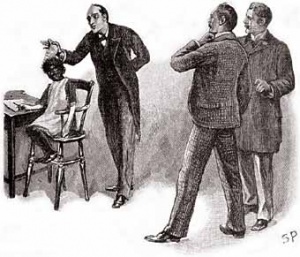
This week’s story in the Chronological Sherlock Holmes Challenge is one I don’t remember reading about 20 years ago, though I must have because I did read all the stories. It’s interesting that I don’t recall it because of the stories I have read so far, I probably enjoyed it the most. A man named Grant Munro shows up to obtain Sherlock Holmes’s services to solve a mystery concerning his wife. Holmes makes a series of impressive deductions about the man’s background and money situation based on the man’s pipe. Munro relates that new neighbors appear to have moved into the cottage across the street from where he lives in Norbury, and he has seen a ghastly face looking out the window. Upon searching the house, he discovers a mysterious portrait of his wife. Further, his wife sneaks out in the middle of the night, and Munro deduces she is visiting the house. Holmes concludes that the occupant of the house must be none other than Mrs. Munro’s first husband, and he must be blackmailing Mrs. Munro. However, once Holmes travels to Norbury at Grant Munro’s request to help Mr. Munro uncover the truth, Holmes discovers he was wrong—the woman is not hiding a first husband at all. The remainder of the review is a tiny bit spoilery.
I have to say, this story surprised me for several reasons. First, it’s refreshing to see Holmes make an incorrect deduction. His deduction makes perfect sense, but he, like many others in the Victorian era, couldn’t have imagined the truth. In addition to the revelation of Holmes’s failure, the ending is a surprise given the times in which the story was written. I would imagine quite a few readers found it shocking, and I know the readers in America would have found it so. I’m not sure if it matters or not, but Mrs. Munro’s first marriage would not have been legal in America in the time at which the story is set (or at least not legal in Georgia, where she lived). Mrs. Munro would not have had an easy time being married to an African-American man at that time. It was not accepted, and Mrs. Munro’s fear regarding the exposure of the truth about her first marriage is quite realistic, though perhaps Mr. Munro’s reaction is less so—it’s the reaction we would want him to have, with our more modern sensibilities, and Watson definitely approves, but it is not the reaction most men in that era would have had.
I see a few references to “The Adventure of the Yellow Face” in the BBC’s Sherlock. First, Mary Morstan’s secretiveness through the series as she hides her past as a hired assassin mirrors Mrs. Munro’s secretiveness about her past. Mary’s behavior is not that different from that of Mrs. Munro’s, and both women seem to expect their new marriages will crumble if their husbands find out about their pasts. There is also a yellow happy face painted on the wall in Sherlock’s apartment. In addition, when Mary is killed by Vivian Norbury, Lady Smallwood’s secretary, Sherlock echoes the request made at the end of this story:
“Watson,” said he, “if it should ever strike you that I am getting a little overconfident in my powers, or giving less pains to a case than it deserves, kindly whisper ‘Norbury’ in my ear, and I shall be infinitely obliged to you.”
In the series, Sherlock makes the request not of Watson (who wasn’t in any shape to listen to it), but of Mrs. Hudson:
Rating:Sherlock Holmes: If you ever think I’m becoming full of myself, overconfident or cocky, would you just say the word “Norbury” to me, would you?
Mrs. Hudson: Norbury?
Sherlock Holmes: Just that. I’d be very grateful.





 I read this story as part of the Chronological Sherlock Holmes Challenge. It is the fifth story in the chronology (time setting rather than composition). Next up is “The Red Circle.”
I read this story as part of the Chronological Sherlock Holmes Challenge. It is the fifth story in the chronology (time setting rather than composition). Next up is “The Red Circle.”